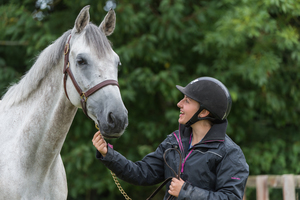
Four ways to build your horse’s core
Ensuring your horse has a strong core will help him to fulfill his athletic potential and avoid injury. Emma Dainty, ACPAT and chartered physiotherapist, discusses why having a strong core is important, and how to achieve it.
Why is a strong core important for your horse?
Core stability is the name given to the strength of the muscles surrounding your horse’s back and abdomen. A strong core supports his back and gives him a solid foundation for correct balance and movement.
‘The top and bottom of your horse need to be balanced in order for him to function efficiently, and this is often described as the ‘string and bow theory’, explains Emma. ‘Imagine an archer’s bow as the spine with the string representing the abdomen – the tighter the string, the more springy the bow (spine).’
Each horse’s core stability is different; but generally, the younger and fitter the horse, the better his natural core stability should be. ‘Conformation, soundness and age play a part in a horse’s core strength,’ says Emma. ‘For example, a horse with a long back will need stronger core muscles to overcome the downward pull of gravity on the gut.
‘Older horses may have less core strength as the ligaments holding the bones together tend to stretch with age, making it harder to contract the muscles, which leads to the commonly seen “sway back” posture. Lame horses may not push evenly on all four limbs, leading to a muscle imbalance.’
By having a good core, your horse’s risk of injury is reduced, as he’s better able to control his joints during slips and trips while carrying a rider, which over-stress joints, tendons and ligaments.
‘A simple test to check your horse’s core stability is to gently lean against him,’ Emma says. ‘Is he able to push back against you or does he have to shift his weight to correct his balance? Is it different on each side?’
Overall, the aim in developing good core stability is to increase your horse’s strength and function, as well as the coordination of all his abdominal and pelvic-stabiliser muscles.
The practical uses of core stability exercises
A strong core will not only improve a horse’s posture, but is also a good exercise for youngsters prior to backing and can help to strengthen hollow back muscles in a horse that has been ridden with ill-fitting tack. Exercising core muscles after a prolonged rest, or when on box rest, can improve sagging abdominals and will also prevent sagging after colic surgery (although this should only be started after consulting your vet). Similarly, improving core stability after kissing spine surgery (again, after a check-up with your vet) will help to maintain condition in these muscles.
Four core stability exercises
Always check with your vet before starting new exercises with your horse and, if in doubt, ask a confident fellow rider to help you the first few times you try these out.
1. Tummy lifts
Apply firm pressure to the spot at which your horse’s girth sits in the middle of his chest, and hold down for 15-20 seconds. In this way you’ll encourage him to flex up through his back and ribs, and work his core muscles while doing so. Do this both before and after riding, and watch exactly how he flexes, as it’s a good indicator of how stiff or mobile his spine is.
Take care to keep this pressure firm, without causing discomfort. Horses can be very sensitive in this area and may threaten to kick or bite.
2. Carrot neck stretches
When asking your horse to bend to either side, his abdominal and pelvic muscles need to contract to prevent him from falling over. These stretches increase the range of motion of the joints in the spine and reactivate the muscles that stabilise these joints.
Do these stretches in a contained area, such as your horse’s stable, where he won’t have much room to move and grab the treat. Stand with your back to his shoulder and hold a carrot or healthy treat out of his reach so that he has to stretch for it. Then ask him to bend around you to try get the treat – keeping it out of biting distance and moving it according to the reps listed below. Perform these five movements on both your horse’s left and right, five times a week:
- Nose to shoulder
- Nose to girth
- Nose to stifle
- Nose to hocks
- Nose down between front fetlocks
Take care that your horse doesn’t ‘mug’ you for the treat or snatch at your hand. Carrots are ideal as they are long enough to protect your fingers! Make sure to keep him engaged, though, by allowing him to eat the treat at the end of every session.
3. Tail pulls
Standing to the side of your horse, and holding his tail below the dock, gently pull so he has to counter-balance against you. You’ll see your horse’s abdominals and stifle/thigh muscles contract against the pull. Perform a 10-second hold followed by gently releasing, and repeat this once every day while grooming.
4. Raised walk poles in-hand
Place a row of trotting poles approximately one metre apart flat on the floor, and either lead your horse in-hand or long-rein over them, encouraging him to step over each pole at walk while remaining in rhythm. Your horse’s core muscles will engage every time he picks up his feet.
You can then increase the difficulty by raising either one end of the pole or both ends by four inches off the floor to get your horse to step higher. Aim to do this exercise twice a week.



